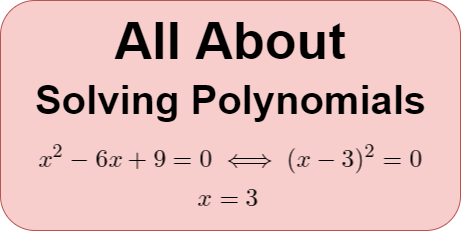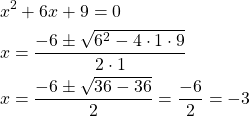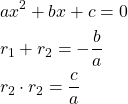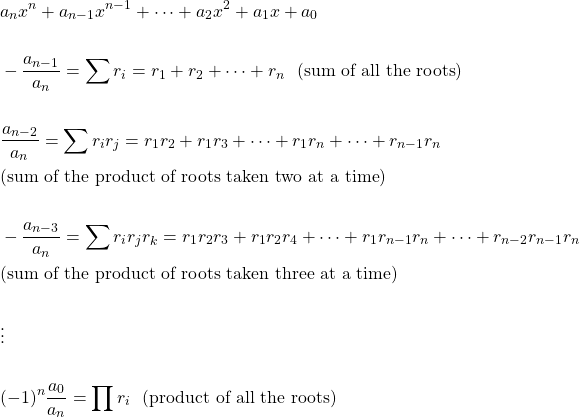Mathematics - All About Solving Polynomials (part 2)

Introduction
Hey it's a me again @drifter1!
Today's article is another high-school refresher on Mathematics, and more specifically on Solving Polynomials. This is the second part. I highly suggest checking out part 1 before this part!
So, without further ado, let's get straight into it!
Basic Algebra - Solving Linear Polynomials
A linear polynomial equation is solved by applying simple algebra. More specifically, we easily end up with an equation of the form x = r, by just moving everything except the term with x to the other side, and dividing by the coefficient of x.
For example:

Basic Algebra can sometimes also be used with higher-degree polynomials as well. It's also possible that known mathematical formulas like differences of squares or cubes occur within the polynomial.
For example:

where now one solution, x = 2, is known, and only a quadratic polynomial remains to be solved!
Quadratic Formula - Solving Quadratic Polynomials
A quadratic polynomial can be solved by applying algebra and mainly factoring, or directly using the Quadratic Formula, which is explained in detail below.
For a quadratic polynomial equation of the form:

the roots are given by:

where the two roots can be equal, yielding a multiple root.
Complex roots are basically the result of a negative square root, which turns the square root section of the formula into:

and always gives a conjugate pair.
For example:

where the multiple root x = -3 allows for a factorized polynomial of the form:

Of course, identifying this square formula earlier, would allow for quicker solving and factorization!
Finding Roots - Factors
The main part of solving a polynomial equation or factoring a polynomial is finding the roots or factors. Sometimes this can be done by inspection, othertimes special techniques need to be used.
In the previous sections we covered how linear and quadratic polynomials can be solved easily, the first using basic algebra, the second using a formula. Similar equations exist for cubic and quartic polynomials as well, but are not common. This section is exactly about how we go about solving such higher-degree polynomials.
Let's start simple...
Monomial Factors
This is exactly why the pre-processing and simplification of the polynomial is so important! Taking a common factor which is a monomial of the form axb, when possible, allows us to identify the so called multiplicity of root x = 0, and also reduces the polynomial's degree by b.
For example, take a look at:

where after taking the common monomial factor only a polynomial of degree 3 has to be solved!
Factoring Formulas
Straight-forward solutions can also be given by expansion and factoring formulas. These are equations such as the perfect square, difference of squares, perfect cube, sum of cubes and difference of cubes.
For example, a difference of cubes can turn out useful in the following way:

After applying the formula one root is now known and equal to:

and the remaining two roots can be found from the quadratic polynomial, and are sadly complex roots (!) which is easy to identify as there is no sign variation.
Rational Root Test
After factoring out the monomial factors and special products, the polynomial degree might still be higher than 2. In that case you may apply formulas for degree 3 or 4 formulas. But, using other techniques is clearly superior, and less time-consuming.
One such technique is the Rational Root Test (or Rational Root Theorem), which gives us the possible rational roots of a polynomial that only contains integer coefficients. In other words, only the rational numbers or integers that come out of that test are candidates for being rational roots of the polynomial. Of course, it doesn't help identify complex or irrational roots. Combining this technique with Descartes’ Rule of Signs can enhance the search for roots even further.
The rule goes as follows. Consider a polynomial in standard form, with only integer coefficients:

If the polynomial has a rational root (or zero) then it must be a fraction of the form p / q, in lowest terms, where:
- p is a factor of the trailing constant (or coefficient) a0
- q is a factor of the leading coefficient an
The smaller these coefficients are, the less the amount of possible candidates, and the faster one can find the actual roots!
Identifying which of these, if any, are roots, can be done by brute-force. Trying out every possible value by substituting x for it in the polynomial. If the result is zero than the candidate is truly a root.
For example, the following polynomial has few candidates:

and substituting those values, helps identify that 1, 2 and -3 are the rational roots.
A better way though, which also jump-starts the next step of the whole solving procedure, is dividing by each canditate factor using polynomial division, or even better a technique known as Synthetic Division. If the candidate is truly a factor then the result of division will be the reduced polynomial that can be used in order to find the remaining roots. More on that technique in the next part!
Coefficients and Roots
The coefficients of the polynomial and its roots are related. Knowing most roots except like one or two, one can use that relationship in order to determine the missing roots.
In the case of a quadratic polynomial, the roots and coefficients are always related as follows:

For example:

The generalization is:

So, creating such sums of products of roots, while knowing most of the roots, can turn the problem of finding roots into solving a simple linear system.
RESOURCES:
References
- https://www.mathsisfun.com/algebra/polynomials-solving.html
- https://www.khanacademy.org/math/algebra-home/alg-polynomials
- https://brownmath.com/alge/polysol.htm
Mathematical equations used in this article, have been generated using quicklatex.
Block diagrams and other visualizations were made using draw.io.
Final words | Next up
And this is actually it for today's post!
The next and final part will be posted in the following days...
The next "All About" article will be about:
- Exponentials and Logarithms
Basically more High-School Math Refreshers!
See ya!

Keep on drifting!
Posted with STEMGeeks